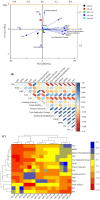Effects of screw-pressing temperature on the functional properties and structural characteristics of apricot (Prunus armeniaca L.) kernel protein isolates
- PMID: 40661683
- PMCID: PMC12256547
- DOI: 10.3389/fnut.2025.1619072
Effects of screw-pressing temperature on the functional properties and structural characteristics of apricot (Prunus armeniaca L.) kernel protein isolates
Abstract
This study aimed to investigate the effect of screw-pressing temperature on the quality of apricot kernel protein isolates (API). The API values at different screw-pressing temperatures (40-200°C) were obtained, and the functional and structural properties of different API samples were comparatively studied. The results revealed that the total polyphenol content (TPC), total flavonoid content (TFC), and antioxidant activities (DPPH and FRAP assays) increased significantly with increasing temperature. High-temperature pressing also increased the surface hydrophobicity and emulsification of API. SDS-PAGE confirmed the preservation of the primary structure of API, with molecular weights ranging from 13 to 20 kDa and 36-56 kDa. Circular dichroism (CD) spectroscopy analysis revealed that the α-helix content increased (by 4-8%) and the β-sheet content decreased (by 2-5%) when the samples were pressed at high temperatures. The decrease in fluorescence intensity and the fluorescence spectral shift indicated changes in the tertiary structure. Multivariate statistical analysis revealed that the antioxidant activities were positively correlated to protein carbonyls, free sulfhydryl groups, surface hydrophobicity, TPC, and TFC. Mechanistically, thermally-induced protein conformational changes and surface hydrophobicity modulation drove the observed enhancements in functional properties. These findings will collectively serve as a theoretical basis for the efficient preparation and application of API.
Keywords: apricot kernel protein isolate; functional properties; multivariate statistical analysis; screw-pressing temperatures; structural characteristics.
Copyright © 2025 Zhang, Wu, Wang, Zhou, Bayinkexike, Cui, Song and Liu.
Conflict of interest statement
XZ was employed by Bazhoujiamu Agroscience Co., Ltd. The remaining authors declare that the research was conducted in the absence of any commercial or financial relationships that could be construed as a potential conflict of interest.
Figures






Similar articles
-
Effect of screw pressing temperature on yield, bioactive compounds, and quality of hemp (Cannabis sativa L.) seed oil.J Cannabis Res. 2025 Jun 18;7(1):37. doi: 10.1186/s42238-025-00296-6. J Cannabis Res. 2025. PMID: 40533871 Free PMC article.
-
Optimization of Ethanol Extraction Conditions From Sun-Dried Apricot and Prediction of Antioxidant, Phenolic, and Flavonoid Contents and Their Effects on HCT116 Cells Using Artificial Neural Networks.Food Sci Nutr. 2025 Jul 17;13(7):e70610. doi: 10.1002/fsn3.70610. eCollection 2025 Jul. Food Sci Nutr. 2025. PMID: 40678329 Free PMC article.
-
Intravenous magnesium sulphate and sotalol for prevention of atrial fibrillation after coronary artery bypass surgery: a systematic review and economic evaluation.Health Technol Assess. 2008 Jun;12(28):iii-iv, ix-95. doi: 10.3310/hta12280. Health Technol Assess. 2008. PMID: 18547499
-
Sexual Harassment and Prevention Training.2024 Mar 29. In: StatPearls [Internet]. Treasure Island (FL): StatPearls Publishing; 2025 Jan–. 2024 Mar 29. In: StatPearls [Internet]. Treasure Island (FL): StatPearls Publishing; 2025 Jan–. PMID: 36508513 Free Books & Documents.
-
Systemic pharmacological treatments for chronic plaque psoriasis: a network meta-analysis.Cochrane Database Syst Rev. 2021 Apr 19;4(4):CD011535. doi: 10.1002/14651858.CD011535.pub4. Cochrane Database Syst Rev. 2021. Update in: Cochrane Database Syst Rev. 2022 May 23;5:CD011535. doi: 10.1002/14651858.CD011535.pub5. PMID: 33871055 Free PMC article. Updated.
References
LinkOut - more resources
Full Text Sources
Miscellaneous

